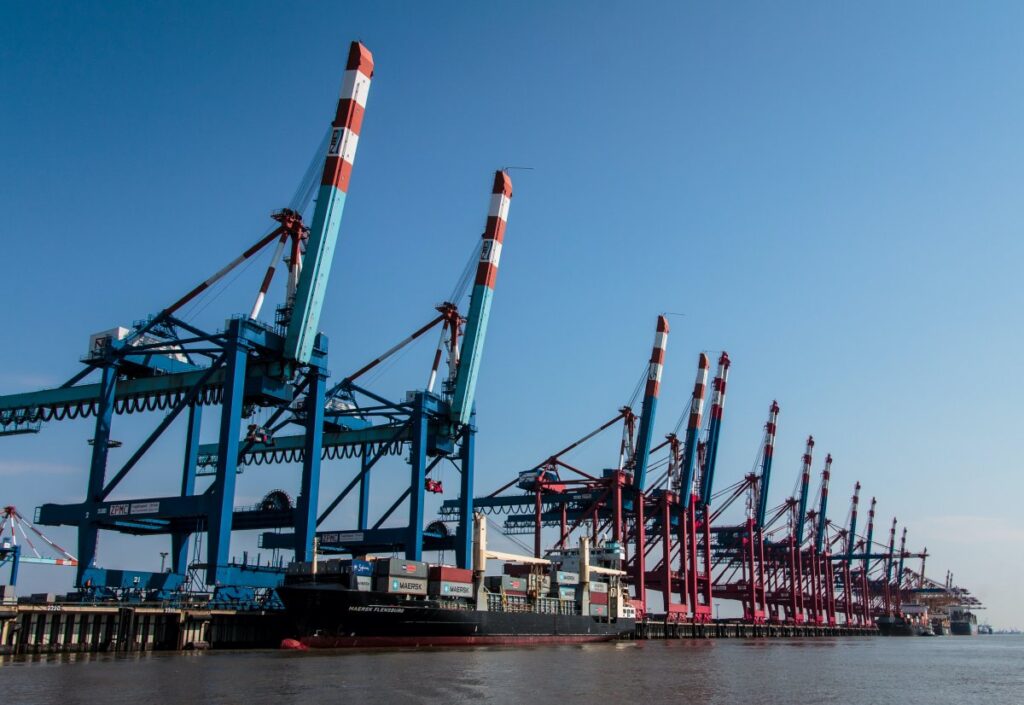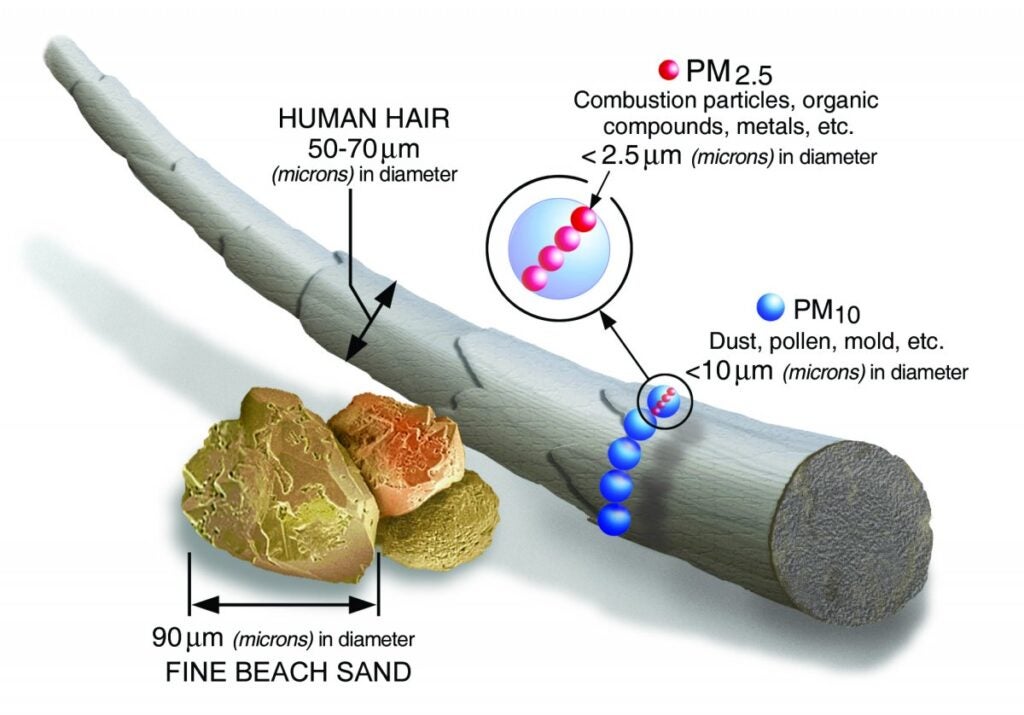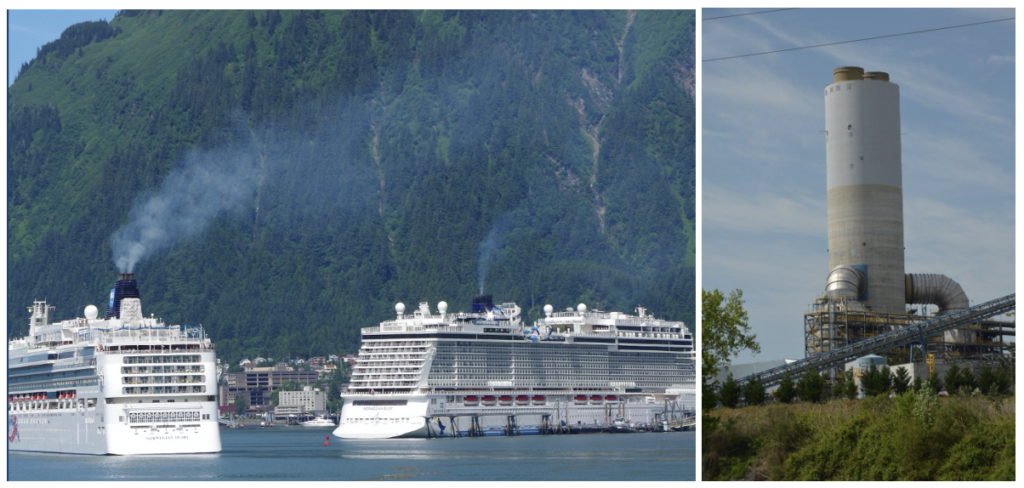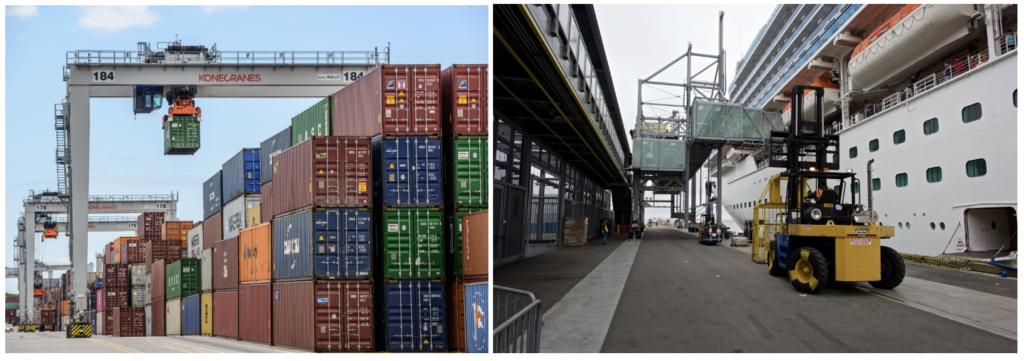22. Cleaning Up Diesel Emissions at Our Ports
Author: Dr. James A. Fawcett, USC Sea Grant Maritime Policy Specialist/Extension Director (retired)
Media Contact: Leah Shore / lshore@usc.edu / (213)-740-1960
We have all heard of the diesel engine. But do we know how and when it became the world’s most popular type of engine? Late in the 19th Century, the German engineer, Rudolf Diesel had an idea: utilize the socalled Carnot Cycle, a spark-ignition heat engine cycle developed earlier in the century, to design an engine that would generate power by compressing a fuel in a cylinder resulting in kinetic energy in the form of rotation. In other words, he wanted to design an internal combustion engine that required no spark to operate but instead, with adequate fuel, could run continuously. The thermal efficiency of such an engine would be far greater than its spark-ignition competitor. Altering his initial designs, he was able to patent his unique invention by 1895 in Germany and 1898 in the U.S. Since then, diesel engines power almost all heavy-duty equipment worldwide. They operate on less-refined fuel than spark-ignition engines, they generate torque at lower engine speeds than other internal combustion (I-C) engines, and they are simpler and more reliable than their gasoline-powered cousins. In the maritime world, diesel engines are ubiquitous.

Diesel Particulate Matter (DPM)
While they are common because of their efficiency, power, and simplicity, diesel engines are also known for their exhaust pollution products. The engines produce pollution similar to spark-ignition engines with the addition of diesel particular matter (DPM), or the fine particles of soot that we see emanating from diesel trucks. This soot is one of six “criteria air pollutants,”[1] that have been identified by the U.S. Environmental Protection Agency (EPA) as the important components of air pollution causing human respiratory disease. They are: CO (carbon monoxide), O3 (ozone), NOx (oxides of nitrogen), SO2 (sulfur dioxide), Pb (lead), and DPM. The Clean Air Act[2] sets standards for the reduction of these pollutants, specifying that the EPA can regulate and enforce compliance with emissions limits for these components of engine exhaust.
The main effort by engine manufacturers and operators is to limit three of these pollutants: NOx, SO2, and DPM. CO is a normal emission product of all types of combustion, and O3 is a normal product of oxidation, especially in an internal combustion environment, therefore they are inherent products of burning petroleum fuel. In an earlier essay, we discussed the exhaust emissions of ships that visit our twin ports and the methods that the ports have developed to reduce those emissions. In this essay, we are focused on strategies for reducing emissions from container cranes and other diesel-powered yard equipment, especially the vast fleets needed to move intermodal containers from ships to trains and trucks. Each of the three pollutants responds differently to remediation, and it is likely that diesel-powered yard equipment will continue to be widely used even when new generations of equipment will be powered by less polluting or non-polluting sources of energy. Until that day, the primary objective will continue to be limiting the pernicious emission products of these engines.

Cleaning up NOx
Of the three pollutants, oxides of nitrogen (NOx) are the most complex to remove because they need both chemical transformation and specialized equipment to be installed on each vehicle/engine. NOx is formed in the high pressure and very hot environment of diesel engines which, without a spark igniter, rely upon much higher pressure to ignite the fuel and air mixture. The air supporting combustion is already mostly nitrogen in the form of N2, and as power is generated by the pressure of the burning fuel, nitrogen becomes oxidized. While in operation, diesel engines will emit NOx in the exhaust environment, but with a spray of urea (CO(NH2)2) in the catalytic converter, they will convert NOx to N2 and water,[3] neither of which is harmful to the environment. Therefore although it is an intricate process, the addition of urea has made the ability to reduce NOx emissions more efficient.
Cleaning up DPM
Diesel particulate matter is more colloquially known as soot, and we can often find it nearby when organic fuels are incompletely burned. The residue consists mainly of fine particles of carbon that are so small that they float in the wind and eventually are deposited on any nearby surface. DPM has been a target of the EPA because while suspended in air, they are available for people and animals to breathe. Measured in microns (a micron is 0.001 millimeter), the EPA is particularly concerned about PM2.5 or particulate matter of the size of 2.5 microns. That is about the size of some bacteria and, obviously, very small. It is especially hazardous for children because if they’re outside exercising as they do in primary school playgrounds, they tend to breathe more deeply than adults. If children are in an environment with DPM present in the air, the small soot particles can be breathed deeply into their lungs. For young kids, air contaminants inspired into their growing lungs can create damage early in life, leading to serious breathing problems later. Many of the smoke and air quality apps used frequently now in the Western U.S during fire season are using measurements of PM2.5 to determine the various colors of quality, with dark red and purple air being the worst.
For mobile sources of DPM, the most effective method of reducing its concentration is by the use of a filter.[4] The authors of this research, He, Chen, and Xu, note that electrostatic precipitation of soot can remove as much as 90% of DPM in the exhaust column, but the filter needs frequent cleaning to maintain its effectiveness. In practical terms, a portion of the power generated by the diesel engine will be needed to power the filtration system, and time and labor are also needed to remove the collected precipitate. But, for mobile sources, filtration such as they describe, is the most effective means of reducing both large PM10 and small PM2.5 particles.
Interestingly enough, Scott (cited above) claims that adding urea to the exhaust stream in a catalytic system can reduce not only the oxides of nitrogen but is also effective at remediating DPM (likely through wet filtration).

Cleaning Up Sulfur Dioxide (SO2)
For mobile sources of SO2, such as vehicles, the easiest and most practical method of removal in diesel exhaust is to fuel the vehicles with low-sulfur diesel fuel. In the US, the current standard for on-road diesel fuel must contain no more than 15 parts per million of sulfur (15 ppm).[5] Those same standards apply to off-road use. For comparison, prior to 1993, the allowable sulfur content of diesel was 5,000 ppm. It was reduced to 500 ppm in 1993 and reduced again to 15 ppm in 2010.[6] Although for mobile sources, the only reasonable strategy has been to clean up the fuel rather than attempting to clean it in the exhaust stream, that is not true for power plants and other facilities that burn petroleum or coal as a feedstock. For these sources using coal or so-called residual fuels, more elaborate remediation strategies must be used, including stack-gas scrubbers.

Alternatives to Cleaning the Exhaust Stream
Loaded intermodal containers weighing as much as 30 tons require robust yard transfer equipment that have run on diesel engines for decades. These engines have been shown to be durable, low-maintenance, powerful, and use a consistent type of fuel, all factors promoting wide use on container terminals worldwide. Container terminals, too, are the focus of our attention because they utilize a wide variety and abundance of on-dock equipment,[7] unlike other types of cargo vessels.
While containerships docking in our two ports can now connect to shore power and shut down their internal main and auxiliary diesel engines, mobile yard equipment does not enjoy that luxury. Either it must find a way to minimize its exhaust emissions or find another source of power. Both Eco-Cranes and Konecranes have found a hybrid method of providing electricity to mobile equipment by mounting a small diesel generator on some of its yard equipment and using intermittent diesel power to recharge a battery bank on the same vehicle.[8] In a normal service cycle of 8 hours, a rubber-tired gantry crane (RTG) could be operated on batteries exclusively for 5 of those hours[9] and for three hours by a diesel generator.
Furthermore, the small diesel engine applied to this application[10] would generate 129kW of power, small enough to meet Tier 4 EPA emission regulations. With the Selective Catalytic Reduction (SCR) system with urea injection, it would reduce the DPM emitted. These benefits apply to the large size of RTG equipment where there is space for a large battery bank. (I do not have information on other types of hybrid or battery-only yard equipment of smaller size.)
Ship-to-shore container cranes, because of their size and available space for installation of alternative sources of electric power, are equally attractive as sites for transforming on-dock diesel-only equipment to hybrid power. Their power requirements are considerably greater than those of RTG gantry cranes, but their size also provides more space for power packs. The issues as noted below will be similar to those experienced with smaller RTG mobile yard cranes.

The Future: Economic Considerations and Replacement Strategies
Transformations in accustomed technologies often take time and commonly occur in phases, as we have seen with electric automobiles slowly replacing cars with internal combustion engines. Early adopters of electric cars have experienced the thrill of new technology but also pay a premium price early on. The new devices eventually become cheaper as manufacturing efficiencies and design efficiencies emerge. A similar effect will likely appear as container yards begin replacing diesel-powered yard equipment with other newer technologies.
Fuel cells are the most likely new, future power source that is even less polluting than Tier 4 diesel engines feeding battery banks.[11] Yet, facing the prospect of an expensive replacement strategy from diesel to hybrid-diesel-electric, and noting the possible near-term opportunities for clean fuel cell power, terminal operators may consider biding their time and waiting for the next alternative. Long-term costs and air quality regulatory compliance are likely to be the controlling factors in these equipment replacement decisions as operators stand by in a rapidly changing technological and regulatory environment. The next decade will undoubtedly see evolution in remediation technologies benefitting all who live and work in proximity to our seaports.

References
[1] See https://www.epa.gov/criteria-air-pollutants.
[2] 42 U.S.C., 7401 et seq.
[3] Scott, P. (August 3, 2022). What is the Use of Urea in Diesel? https://www.wikimotors.org/what-is-the-use-of-urea-in-diesel.htm
[4] He, J, Chen, K and Xu, J. (2017). Urban Air Pollution and Control. https://www.sciencedirect.com/science/article/abs/pii/B9780124095489101824
[5] U.S. Energy Information Administration. (July 7, 2022). Diesel Fuel Explained. https://www.eia.gov/energyexplained/dieselfuel/#:~:text=Diesel%20fuel%20now%20sold%20in%20the%20United%20States
[6] Ciolkosz, D. (2010). Know the Sulfur Content of Your Diesel Fuel. https://extension.psu.edu/knowthesulfur-content-of-your-diesel-fuel.
[7] Diesel powered yard equipment such as straddle carriers, rubber-tired gantry cranes, fork lift trucks (lifts containers from a tall stack), reach stackers (lifts containers from an obstructed stack), top lift trucks (lifts containers from the top of a stack), and Hostlers (terminal tractors).
[8] Personal conversation: 21 July 2022. Abby Swaine, Clean Freight Programs, EPA Region I, Boston, MA.
[9] Konecranes. N.d. Ecolifting Retrofits: Hybrid. https://www.konecranes.com/sites/default/files/2020-06/Hybrid%20Retrofit_2020.pdf
[10] Cummins. N.d. BSIV Selective Catalytic Reduction. https://www.cummins.com/engines/qsb45-tier-4-finalstage-iv
[11] Hydrogen Fuel News. N.d. NYK Line begins operating cranes deemed hydrogen fuel cell ready. https://www.hydrogenfuelnews.com/hydrogen-fuel-cell-nyk/8554052/